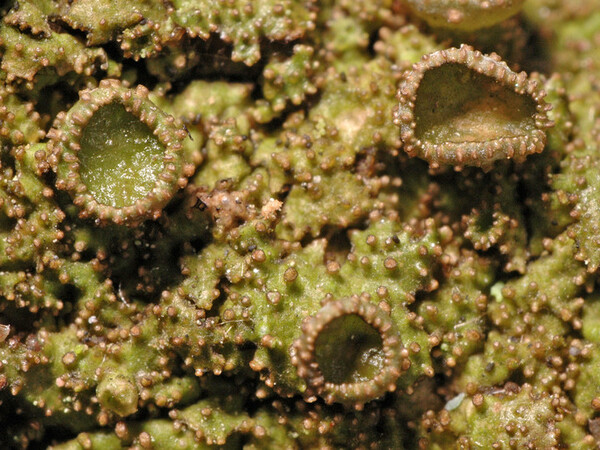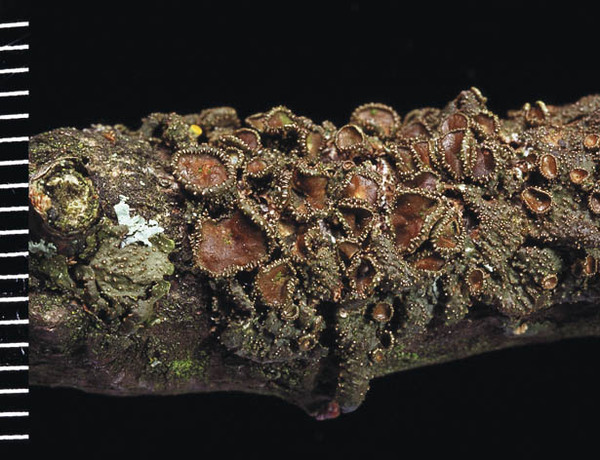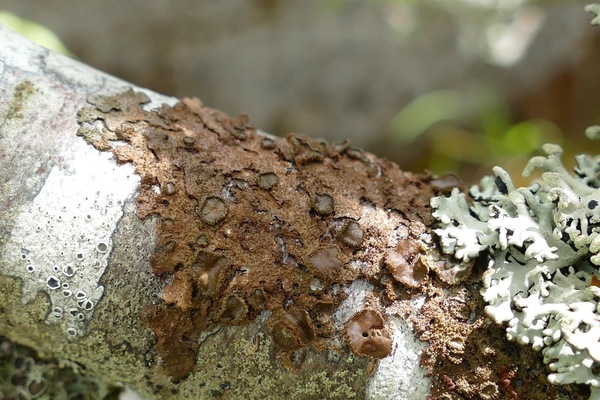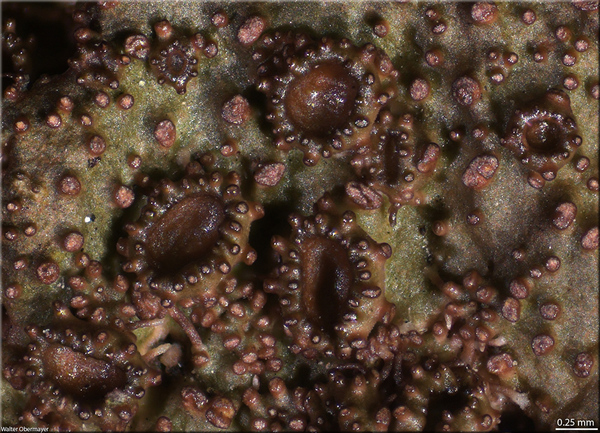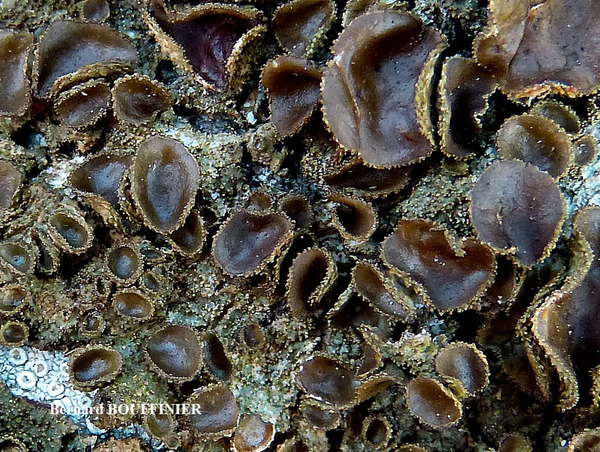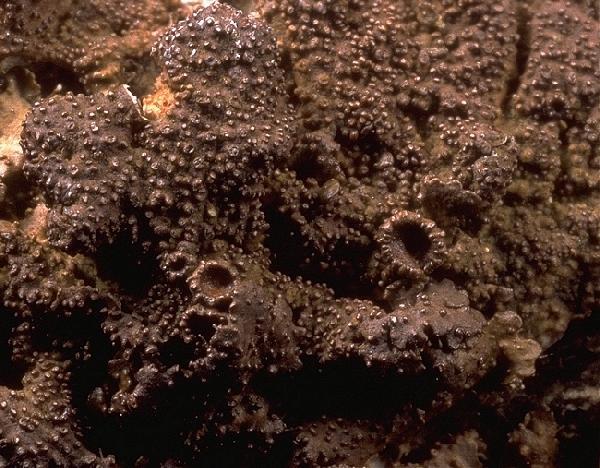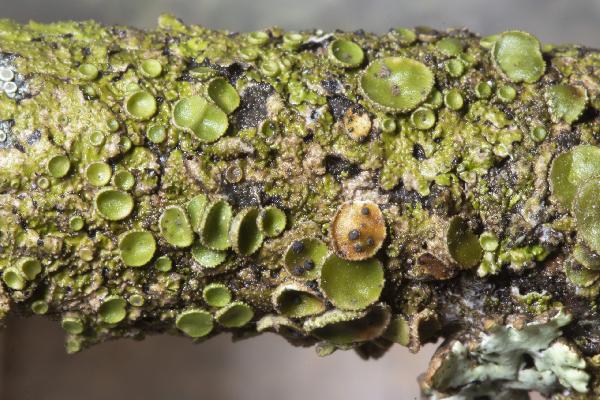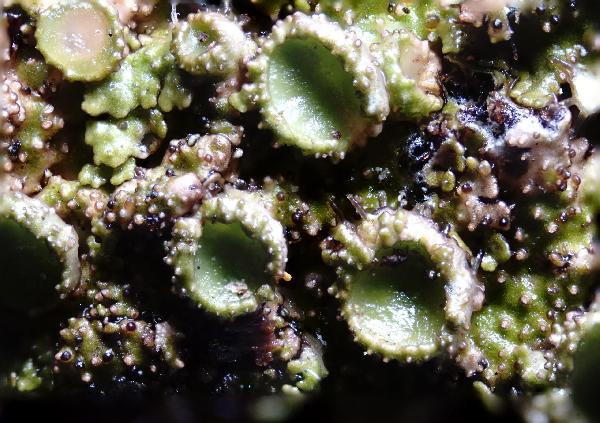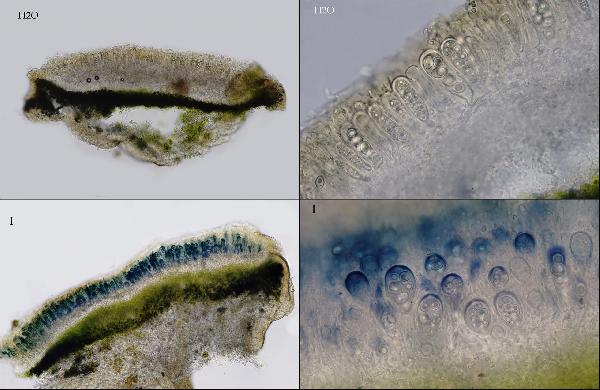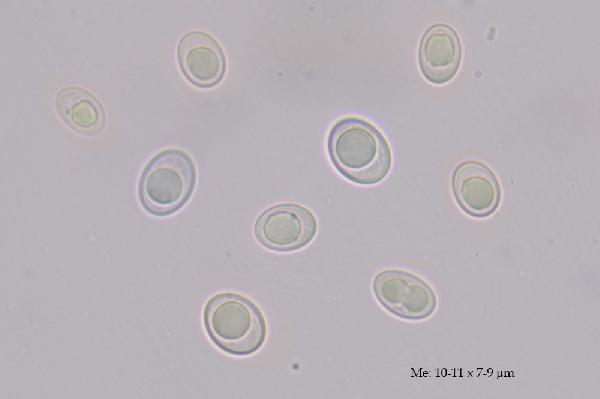Melanohalea exasperata (De Not.) O. Blanco, A. Crespo, Divakar, Essl., D. Hawksw. & Lumbsch
Mycol. Res., 108: 882, 2004. Basionym: Parmelia exasperata De Not. - Giorn. Bot. Ital., 2: 193, 1847.
Synonyms: Imbricaria aspera (A. Massal.) Körb.; Imbricaria aspidota (Ach.) Rehm; Melanelia exasperata (De Not.) Essl.; Parmelia aspera A. Massal.; Parmelia aspidota (Ach.) Röhl.; Parmelia aspidota var. exasperata (De Not.) P. Syd.
Distribution: N - VG, Frl (Castello & Skert 2005, Tretiach & Molaro 2007, Bernini & al. 2010), Ven (Nimis & al. 1996c, Nascimbene & Caniglia 1997, Caniglia & al. 1999, Lazzarin 2000b, Nascimbene 2005c, 2008c, Nascimbene & Marini 2007), TAA (Nascimbene 2005b, Nascimbene & al. 2007b, 2022, Nimis & al. 2015), Lomb (Roella 1999, Furlanetto 2010), Piem (Caniglia & al. 1992, Isocrono & Falletti 1999, Isocrono & al. 2003, Piervittori 2003, Furlanetto 2010), Emil (Gasparo & Tretiach 1996, Benesperi 2009, Fariselli & al. 2020), Lig (Brunialti & Giordani 2000, Giordani & al. 2002, Brunialti & Giordani 2003). C - Tosc (Tretiach & Nimis 1994, Loppi & al. 1996b, 1998, 2002, 2006, Monaci & al. 1997, Putortì & al. 1998, Tretiach & Ganis 1999, Putortì & Loppi 1999b, Loppi & Frati 2006, Benesperi 2011, Brackel 2015), Marc (Gasparo & al. 1989, Nimis & Tretiach 1999, Frati & Brunialti 2006), Umb (Ravera 1998, Nimis & Tretiach 1999, Ravera & al. 2006, Panfili 2007, Brackel 2015), Laz (Nimis & Tretiach 2004, Ruisi & al. 2005, Brackel 2015), Abr (Nimis & Tretiach 1999, Brackel 2015, Caporale & al. 2016, Gheza & al. 2021), Mol (Garofalo & al. 1999, Nimis & Tretiach 1999, Caporale & al. 2008, Genovesi & Ravera 2014, Brackel 2020, Caporale & Ravera 2020), Sar (Zedda 1995, 2002, Zedda & al. 2001, Rizzi & al. 2011, Cossu 2013,Brackel & Berger 2019, Di Nuzzo & al. 2022). S - Camp (Garofalo & al. 1999, 2010, Aprile & al. 2003, 2003b, 2011, Nimis & Tretiach 2004, Nascimbene & al. 2010b, Brunialti & al. 2013, Ravera & Brunialti 2013, Catalano & al. 2016), Pugl (Garofalo & al. 1999, Nimis & Tretiach 1999, Durini & Medagli 2004, Brackel 2011), Bas (Nimis & Tretiach 1999, Potenza 2006, Brackel 2011), Cal (Puntillo 1995, 1996, van den Boom & Giralt 2002, Puntillo & Puntillo 2004, Incerti & Nimis 2006), Si (Grillo & Cristaudo 1995, Schicchi & al. 1997, Merlo 2004b, Falco Scampatelli 2005, Caniglia & Grillo 2006b, Iacolino & Ottonello 2006, Brackel 2008b, 2008c, Di Martino & Stancanelli 2015, Campisi & al. 2020, Brackel & Puntillo 2023).
Description: Thallus foliose, heteromerous, dorsiventral, tightly adpressed, forming 2-6 cm wide rosettes. Lobes 2-4(-6) mm wide, usually contiguous, pale to dark olive brown, dull to moderately shiny, especially at margins, sometimes white-pruinose at tips and margins, thin, rounded at tips, with numerous, more or less homogeneously scattered, conical, up to 0.1 mm wide, isidia-like papillae with a small central depression (actually raised pseudocyphellae!). Lower surface black, pale brown at margins, with simple rhizines. Upper cortex paraplectenchymatous, with a non-pored epicortex, the cell walls containing isolichenan; medulla white; lower cortex paraplectenchymatous. Apothecia almost always present, lecanorine, bowl-shaped, sessile, 2-6 mm across, with a brown disc and a thalline margin covered in numerous papillae. Epithecium brown; hymenium and hypothecium colourless. Asci 8-spored, clavate, the K/I+ blue tholus penetrated by a faintly amyloid apical cushion with parallel or diverging flanks, the wall K/I-, surrounded by a K/I+ blue outer layer, Lecanora-type. Ascospores 1-celled, hyaline, ellipsoid, 8-12 x 5-7 µm. Pycnidia common, dark, immersed, laminal. Conidia slightly dumbbell-shaped, 7-8 x 1 µm. Photobiont chlorococcoid. Spot tests: cortex and medulla K-, C-, KC-, P-, N-, UV-. Chemistry: without lichen substances.Note: a mainly temperate to Mediterranean early coloniser of smooth bark, most common on twigs of shrubs and deciduous trees (e.g. Prunus, Quercus) below the subalpine belt. A cryptic species, M. davidii Divakar et al., undistinguishable morphologically from M. exasperata, has been recently described from two localities in Spain.
Growth form: Foliose, broad lobed
Substrata: bark
Photobiont: green algae other than Trentepohlia
Reproductive strategy: mainly sexual
Pioneer species
Commonnes-rarity: (info)
Alpine belt: absent
Subalpine belt: absent
Oromediterranean belt: absent
Montane belt: rather rare
Submediterranean belt: rather common
Padanian area: extremely rare
Humid submediterranean belt: common
Humid mediterranean belt: rather common
Dry mediterranean belt: rather rare
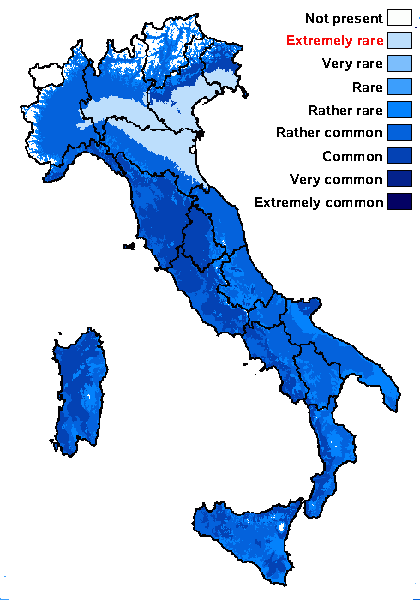
Predictive model
Herbarium samples
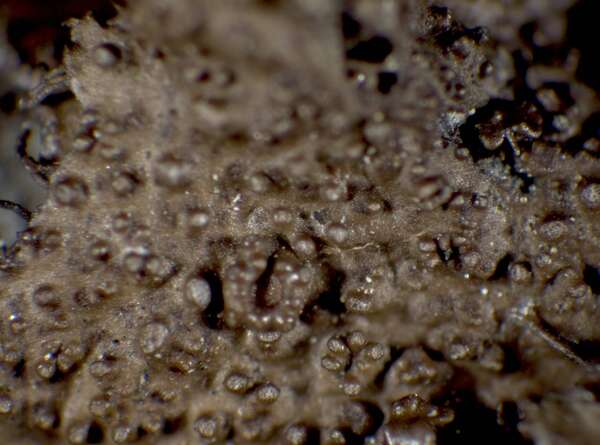

P.L. Nimis; Owner: Department of Life Sciences, University of Trieste
Herbarium: TSB
2001/12/03
detail of upper surface with young apothecium and papillae


P.L. Nimis; Owner: Department of Life Sciences, University of Trieste
Herbarium: TSB (34326)
2001/12/27
apothecia
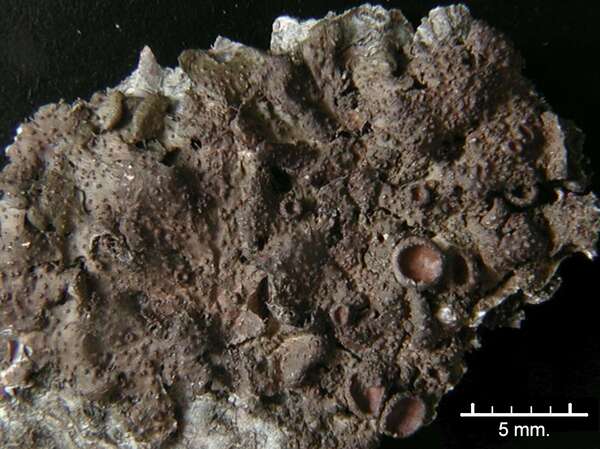

G. Incerti; Owner: Department of Life Sciences, University of Trieste
Herbarium: TSB (32098)
2001/11/26
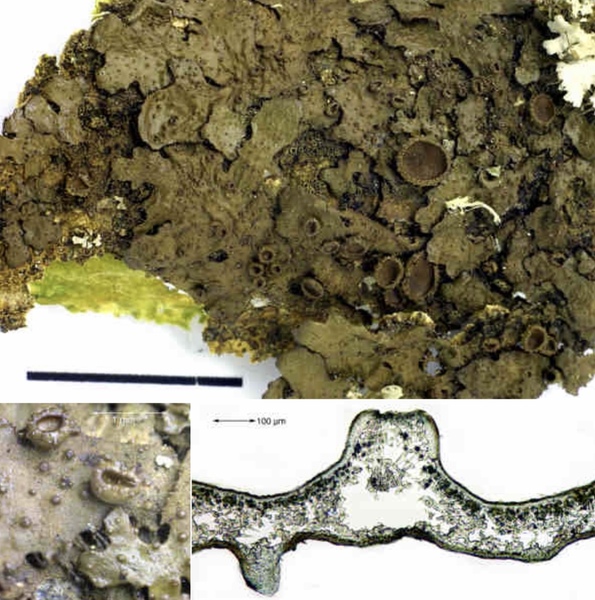

Felix Schumm – CC BY-SA 4.0
Image from: F. Schumm (2008) - Flechten Madeiras, der Kanaren und Azoren. Beck, OHG - ISBN: 978-3-00-023700-3
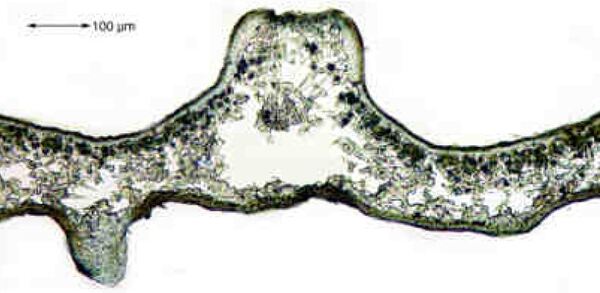

Felix Schumm - CC BY-SA 4.0
Image from: F. Schumm (2008) - Flechten Madeiras, der Kanaren und Azoren. Beck, OHG - ISBN: 978-3-00-023700-3
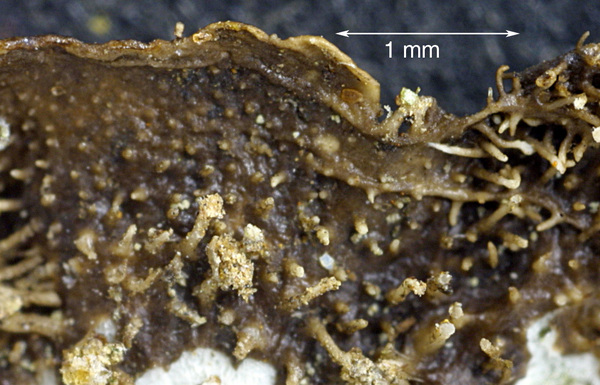

Felix Schumm - CC BY-SA 4.0
[5247], Spanien, Gran Canaria, Pinus canariensis - Erica arborea -Wald ca. 2 km östlich von La Culata; 27°58.518 N, 15°34.977 W, alt. 1700 m. Leg. F. Schumm & U. Schwarz, 25.12.1998, det. F. Schumm, 31.01.1999, conf. Elix 1999.
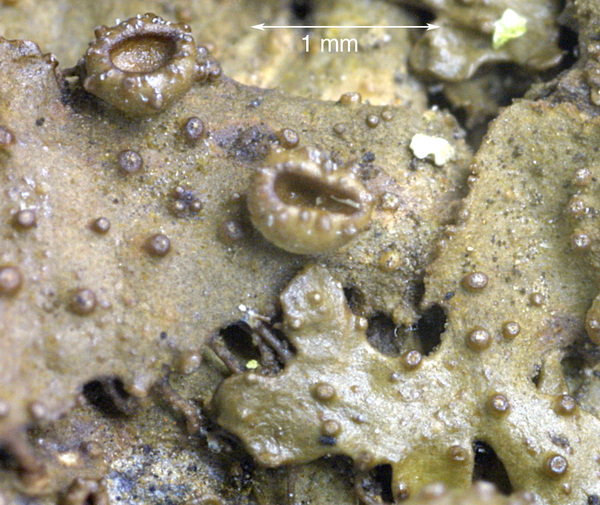

Felix Schumm - CC BY-SA 4.0
[5247], Spanien, Gran Canaria, Pinus canariensis - Erica arborea -Wald ca. 2 km östlich von La Culata; 27°58.518 N, 15°34.977 W, alt. 1700 m. Leg. F. Schumm & U. Schwarz, 25.12.1998, det. F. Schumm, 31.01.1999, conf. Elix 1999.
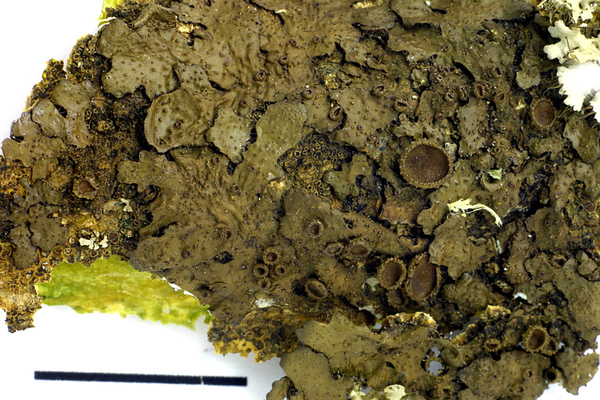

Felix Schumm - CC BY-SA 4.0
[5247], Spanien, Gran Canaria, Pinus canariensis - Erica arborea -Wald ca. 2 km östlich von La Culata; 27°58.518 N, 15°34.977 W, alt. 1700 m. Leg. F. Schumm & U. Schwarz, 25.12.1998, det. F. Schumm, 31.01.1999, conf. Elix 1999.
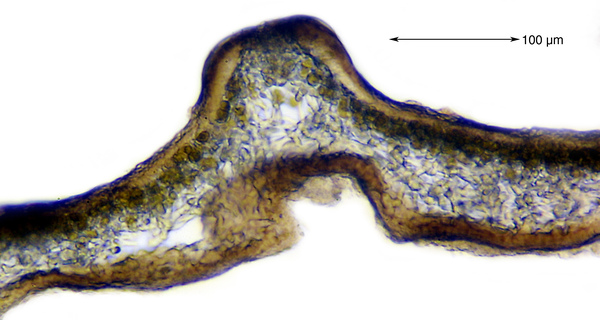

Felix Schumm - CC BY-SA 4.0
[5247], Spanien, Gran Canaria, Pinus canariensis - Erica arborea -Wald ca. 2 km östlich von La Culata; 27°58.518 N, 15°34.977 W, alt. 1700 m. Leg. F. Schumm & U. Schwarz, 25.12.1998, det. F. Schumm, 31.01.1999, conf. Elix 1999.


Felix Schumm - CC BY-SA 4.0
[5247], Spanien, Gran Canaria, Pinus canariensis - Erica arborea -Wald ca. 2 km östlich von La Culata; 27°58.518 N, 15°34.977 W, alt. 1700 m. Leg. F. Schumm & U. Schwarz, 25.12.1998, det. F. Schumm, 31.01.1999, conf. Elix 1999.
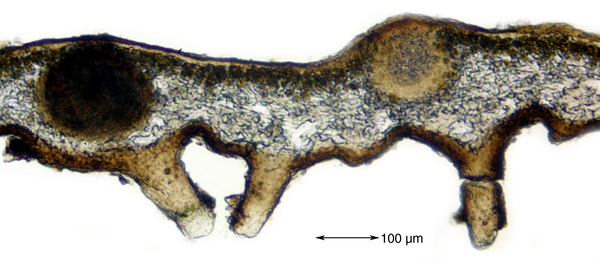

Felix Schumm - CC BY-SA 4.0
[5247], Spanien, Gran Canaria, Pinus canariensis - Erica arborea -Wald ca. 2 km östlich von La Culata; 27°58.518 N, 15°34.977 W, alt. 1700 m. Leg. F. Schumm & U. Schwarz, 25.12.1998, det. F. Schumm, 31.01.1999, conf. Elix 1999.
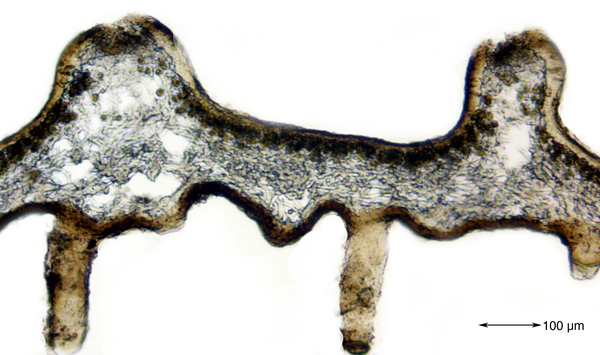

Felix Schumm - CC BY-SA 4.0
[5247], Spanien, Gran Canaria, Pinus canariensis - Erica arborea -Wald ca. 2 km östlich von La Culata; 27°58.518 N, 15°34.977 W, alt. 1700 m. Leg. F. Schumm & U. Schwarz, 25.12.1998, det. F. Schumm, 31.01.1999, conf. Elix 1999.


Felix Schumm - CC BY-SA 4.0
[5247], Spanien, Gran Canaria, Pinus canariensis - Erica arborea -Wald ca. 2 km östlich von La Culata; 27°58.518 N, 15°34.977 W, alt. 1700 m. Leg. F. Schumm & U. Schwarz, 25.12.1998, det. F. Schumm, 31.01.1999, conf. Elix 1999.


Felix Schumm - CC BY-SA 4.0
[5247], Spanien, Gran Canaria, Pinus canariensis - Erica arborea -Wald ca. 2 km östlich von La Culata; 27°58.518 N, 15°34.977 W, alt. 1700 m. Leg. F. Schumm & U. Schwarz, 25.12.1998, det. F. Schumm, 31.01.1999, conf. Elix 1999.


Felix Schumm - CC BY-SA 4.0
[5247], Spanien, Gran Canaria, Pinus canariensis - Erica arborea -Wald ca. 2 km östlich von La Culata; 27°58.518 N, 15°34.977 W, alt. 1700 m. Leg. F. Schumm & U. Schwarz, 25.12.1998, det. F. Schumm, 31.01.1999, conf. Elix 1999.
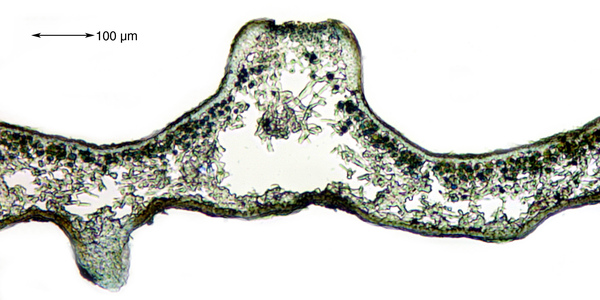

Felix Schumm - CC BY-SA 4.0
[5247], Spanien, Gran Canaria, Pinus canariensis - Erica arborea -Wald ca. 2 km östlich von La Culata; 27°58.518 N, 15°34.977 W, alt. 1700 m. Leg. F. Schumm & U. Schwarz, 25.12.1998, det. F. Schumm, 31.01.1999, conf. Elix 1999.
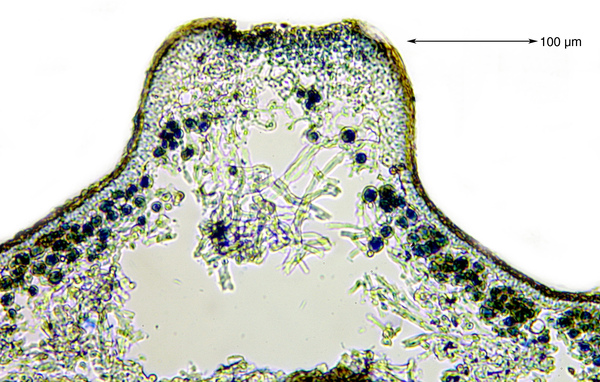

Felix Schumm - CC BY-SA 4.0
[5247], Spanien, Gran Canaria, Pinus canariensis - Erica arborea -Wald ca. 2 km östlich von La Culata; 27°58.518 N, 15°34.977 W, alt. 1700 m. Leg. F. Schumm & U. Schwarz, 25.12.1998, det. F. Schumm, 31.01.1999, conf. Elix 1999.
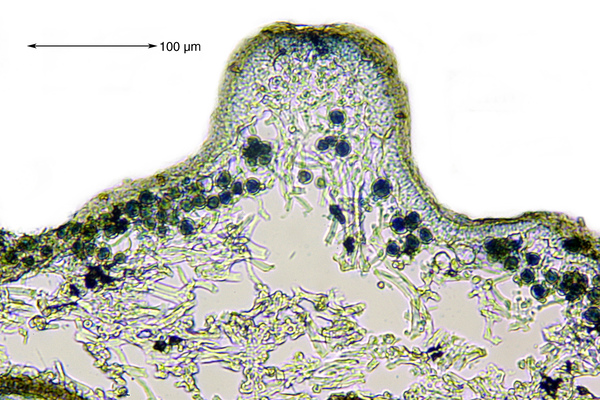

Felix Schumm - CC BY-SA 4.0
[5247], Spanien, Gran Canaria, Pinus canariensis - Erica arborea -Wald ca. 2 km östlich von La Culata; 27°58.518 N, 15°34.977 W, alt. 1700 m. Leg. F. Schumm & U. Schwarz, 25.12.1998, det. F. Schumm, 31.01.1999, conf. Elix 1999.


Felix Schumm - CC BY-SA 4.0
[5247], Spanien, Gran Canaria, Pinus canariensis - Erica arborea -Wald ca. 2 km östlich von La Culata; 27°58.518 N, 15°34.977 W, alt. 1700 m. Leg. F. Schumm & U. Schwarz, 25.12.1998, det. F. Schumm, 31.01.1999, conf. Elix 1999.
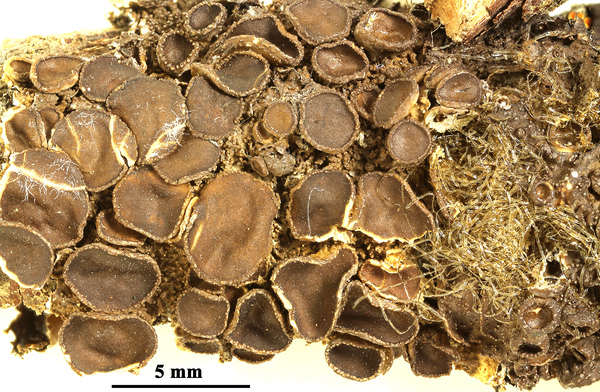

Felix Schumm - CC BY-SA 4.0
[20355], Maroccanum Regnum, Atlas Centralis, 12 km ad meridiem et orientem versus ab Ifrane, ad ramos Crataegi sp. in agro. Annot.: Possible faint trace of an unidentified triterpene, no other compinds detected by TLC- A. Johnson and C.F. Culberson. Leg. W.L. Culberson (16158) et C.F. Culberson, 18.5.1972. A. VEZDA: LICHENES SELECTI EXSICCATI NR. 1736.
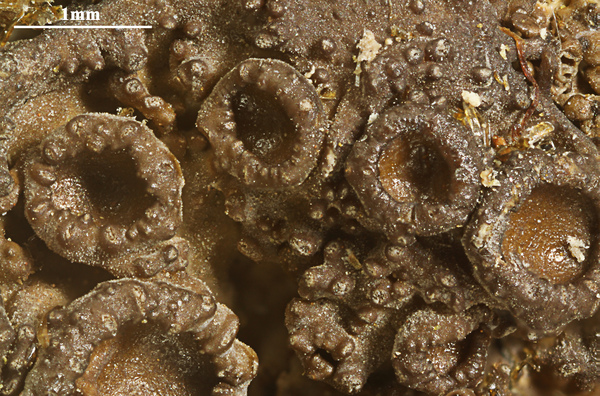

Felix Schumm - CC BY-SA 4.0
[20355], Maroccanum Regnum, Atlas Centralis, 12 km ad meridiem et orientem versus ab Ifrane, ad ramos Crataegi sp. in agro. Annot.: Possible faint trace of an unidentified triterpene, no other compinds detected by TLC- A. Johnson and C.F. Culberson. Leg. W.L. Culberson (16158) et C.F. Culberson, 18.5.1972. A. VEZDA: LICHENES SELECTI EXSICCATI NR. 1736.
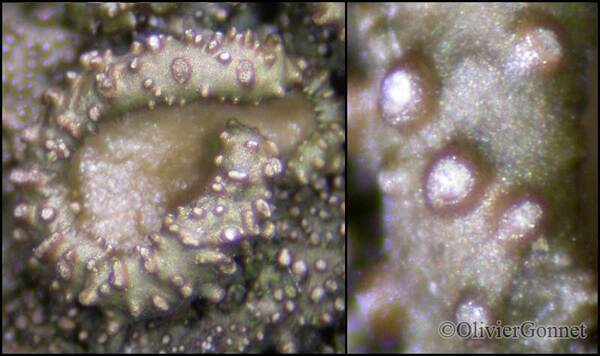
Courtesy Danièle et Olivier Gonnet - Source: https://www.afl-lichenologie.fr/Photos_AFL/Photos_AFL_M/Melanohalea_exasperata.htm
France, sur écorce de feuillu - Excursion AFL 2005 - Lozère
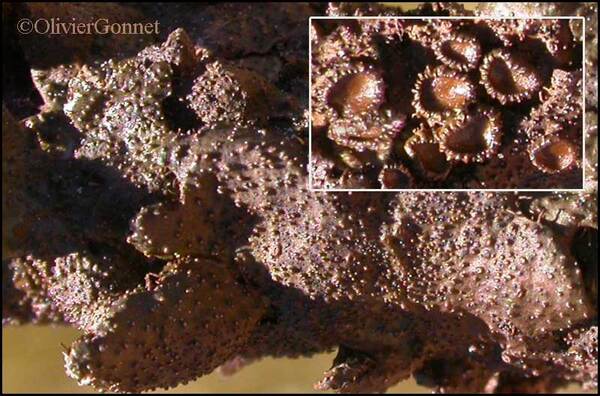
Courtesy Danièle et Olivier Gonnet - Source: https://www.afl-lichenologie.fr/Photos_AFL/Photos_AFL_M/Melanohalea_exasperata.htm
France, sur écorce de feuillu - Excursion AFL 2005 - Lozère
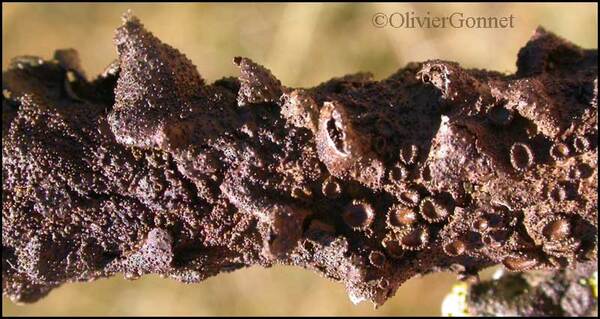
Courtesy Danièle et Olivier Gonnet - Source: https://www.afl-lichenologie.fr/Photos_AFL/Photos_AFL_M/Melanohalea_exasperata.htm
France, sur écorce de feuillu - Excursion AFL 2005 - Lozère
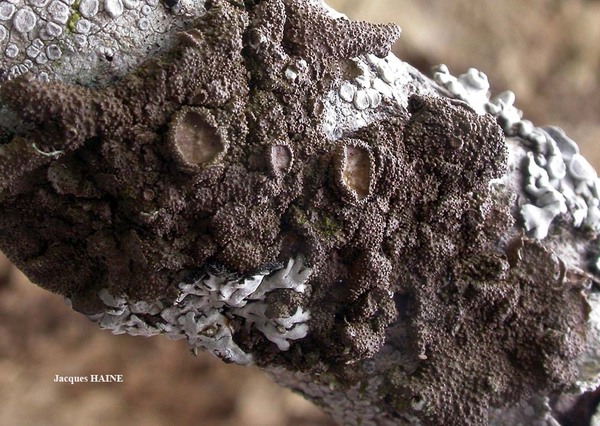
Jacques Haine - Source: http://www.lichensmaritimes.org/index.php?task=fiche&lichen=464&lang=en
France, Drôme Remuzat

Bernard Bouffinier - Source: http://www.lichensmaritimes.org/index.php?task=fiche&lichen=464&lang=en
France, Crozon
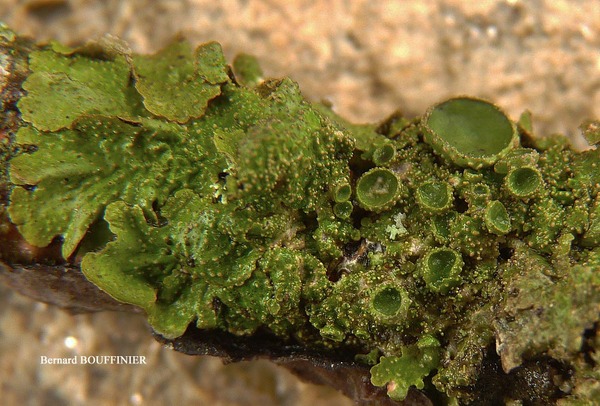
Bernard Bouffinier - Source: http://www.lichensmaritimes.org/index.php?task=fiche&lichen=464&lang=en
France, Crozon
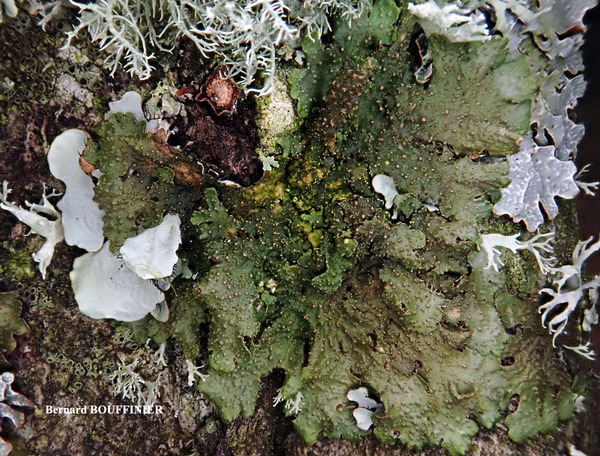
Bernard Bouffinier - Source: http://www.lichensmaritimes.org/index.php?task=fiche&lichen=464&lang=en
France, Crozon
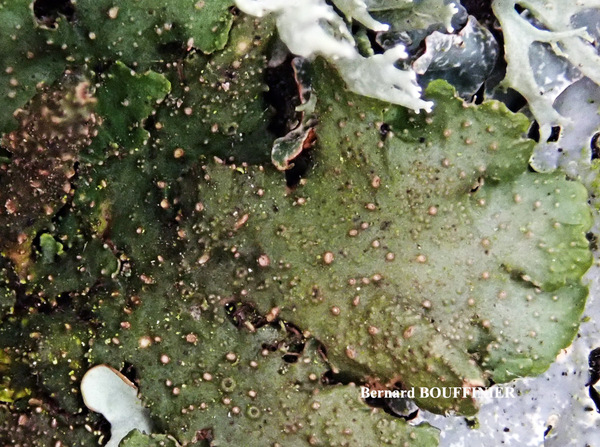
Bernard Bouffinier - Source: http://www.lichensmaritimes.org/index.php?task=fiche&lichen=464&lang=en
France, Crozon
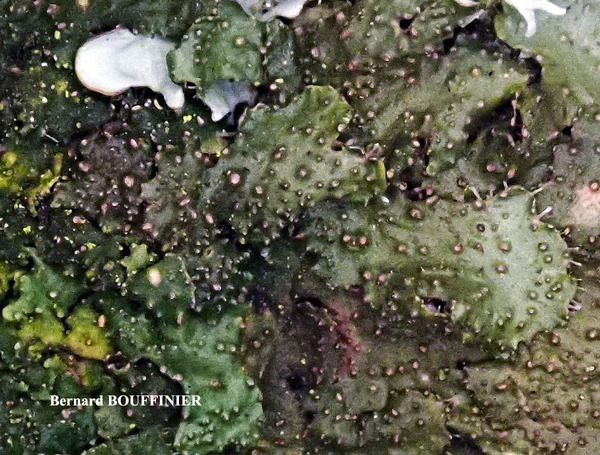
Bernard Bouffinier - Source: http://www.lichensmaritimes.org/index.php?task=fiche&lichen=464&lang=en
France, Crozon

Bernard Bouffinier - Source: http://www.lichensmaritimes.org/index.php?task=fiche&lichen=464&lang=en
France, Crozon
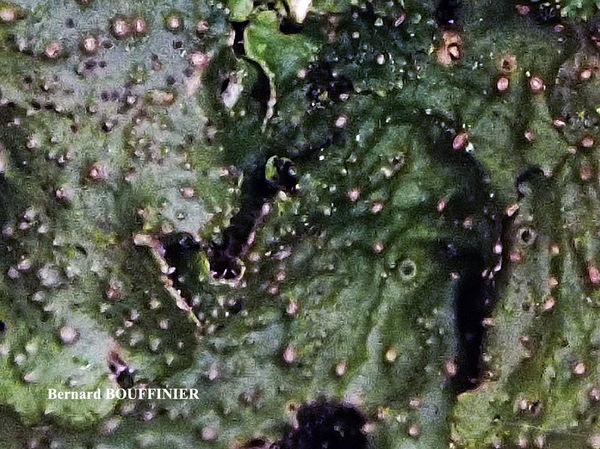
Bernard Bouffinier - Source: http://www.lichensmaritimes.org/index.php?task=fiche&lichen=464&lang=en
France, Crozon
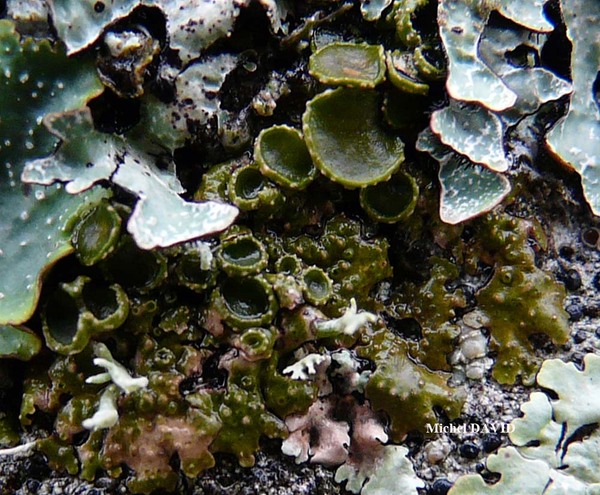
Michel David - Source: http://www.lichensmaritimes.org/index.php?task=fiche&lichen=464&lang=en
France, Crozon
Growth form: Foliose, broad lobed
Substrata: bark
Photobiont: green algae other than Trentepohlia
Reproductive strategy: mainly sexual
Pioneer species
Commonnes-rarity: (info)
Alpine belt: absent
Subalpine belt: absent
Oromediterranean belt: absent
Montane belt: rather rare
Submediterranean belt: rather common
Padanian area: extremely rare
Humid submediterranean belt: common
Humid mediterranean belt: rather common
Dry mediterranean belt: rather rare

Predictive model
| Herbarium samples |


P.L. Nimis; Owner: Department of Life Sciences, University of Trieste
Herbarium: TSB
2001/12/03
detail of upper surface with young apothecium and papillae


P.L. Nimis; Owner: Department of Life Sciences, University of Trieste
Herbarium: TSB (34326)
2001/12/27
apothecia


G. Incerti; Owner: Department of Life Sciences, University of Trieste
Herbarium: TSB (32098)
2001/11/26


Felix Schumm – CC BY-SA 4.0
Image from: F. Schumm (2008) - Flechten Madeiras, der Kanaren und Azoren. Beck, OHG - ISBN: 978-3-00-023700-3


Felix Schumm - CC BY-SA 4.0
Image from: F. Schumm (2008) - Flechten Madeiras, der Kanaren und Azoren. Beck, OHG - ISBN: 978-3-00-023700-3


Felix Schumm - CC BY-SA 4.0
[5247], Spanien, Gran Canaria, Pinus canariensis - Erica arborea -Wald ca. 2 km östlich von La Culata; 27°58.518 N, 15°34.977 W, alt. 1700 m. Leg. F. Schumm & U. Schwarz, 25.12.1998, det. F. Schumm, 31.01.1999, conf. Elix 1999.


Felix Schumm - CC BY-SA 4.0
[5247], Spanien, Gran Canaria, Pinus canariensis - Erica arborea -Wald ca. 2 km östlich von La Culata; 27°58.518 N, 15°34.977 W, alt. 1700 m. Leg. F. Schumm & U. Schwarz, 25.12.1998, det. F. Schumm, 31.01.1999, conf. Elix 1999.


Felix Schumm - CC BY-SA 4.0
[5247], Spanien, Gran Canaria, Pinus canariensis - Erica arborea -Wald ca. 2 km östlich von La Culata; 27°58.518 N, 15°34.977 W, alt. 1700 m. Leg. F. Schumm & U. Schwarz, 25.12.1998, det. F. Schumm, 31.01.1999, conf. Elix 1999.


Felix Schumm - CC BY-SA 4.0
[5247], Spanien, Gran Canaria, Pinus canariensis - Erica arborea -Wald ca. 2 km östlich von La Culata; 27°58.518 N, 15°34.977 W, alt. 1700 m. Leg. F. Schumm & U. Schwarz, 25.12.1998, det. F. Schumm, 31.01.1999, conf. Elix 1999.


Felix Schumm - CC BY-SA 4.0
[5247], Spanien, Gran Canaria, Pinus canariensis - Erica arborea -Wald ca. 2 km östlich von La Culata; 27°58.518 N, 15°34.977 W, alt. 1700 m. Leg. F. Schumm & U. Schwarz, 25.12.1998, det. F. Schumm, 31.01.1999, conf. Elix 1999.


Felix Schumm - CC BY-SA 4.0
[5247], Spanien, Gran Canaria, Pinus canariensis - Erica arborea -Wald ca. 2 km östlich von La Culata; 27°58.518 N, 15°34.977 W, alt. 1700 m. Leg. F. Schumm & U. Schwarz, 25.12.1998, det. F. Schumm, 31.01.1999, conf. Elix 1999.


Felix Schumm - CC BY-SA 4.0
[5247], Spanien, Gran Canaria, Pinus canariensis - Erica arborea -Wald ca. 2 km östlich von La Culata; 27°58.518 N, 15°34.977 W, alt. 1700 m. Leg. F. Schumm & U. Schwarz, 25.12.1998, det. F. Schumm, 31.01.1999, conf. Elix 1999.


Felix Schumm - CC BY-SA 4.0
[5247], Spanien, Gran Canaria, Pinus canariensis - Erica arborea -Wald ca. 2 km östlich von La Culata; 27°58.518 N, 15°34.977 W, alt. 1700 m. Leg. F. Schumm & U. Schwarz, 25.12.1998, det. F. Schumm, 31.01.1999, conf. Elix 1999.


Felix Schumm - CC BY-SA 4.0
[5247], Spanien, Gran Canaria, Pinus canariensis - Erica arborea -Wald ca. 2 km östlich von La Culata; 27°58.518 N, 15°34.977 W, alt. 1700 m. Leg. F. Schumm & U. Schwarz, 25.12.1998, det. F. Schumm, 31.01.1999, conf. Elix 1999.


Felix Schumm - CC BY-SA 4.0
[5247], Spanien, Gran Canaria, Pinus canariensis - Erica arborea -Wald ca. 2 km östlich von La Culata; 27°58.518 N, 15°34.977 W, alt. 1700 m. Leg. F. Schumm & U. Schwarz, 25.12.1998, det. F. Schumm, 31.01.1999, conf. Elix 1999.


Felix Schumm - CC BY-SA 4.0
[5247], Spanien, Gran Canaria, Pinus canariensis - Erica arborea -Wald ca. 2 km östlich von La Culata; 27°58.518 N, 15°34.977 W, alt. 1700 m. Leg. F. Schumm & U. Schwarz, 25.12.1998, det. F. Schumm, 31.01.1999, conf. Elix 1999.


Felix Schumm - CC BY-SA 4.0
[5247], Spanien, Gran Canaria, Pinus canariensis - Erica arborea -Wald ca. 2 km östlich von La Culata; 27°58.518 N, 15°34.977 W, alt. 1700 m. Leg. F. Schumm & U. Schwarz, 25.12.1998, det. F. Schumm, 31.01.1999, conf. Elix 1999.


Felix Schumm - CC BY-SA 4.0
[5247], Spanien, Gran Canaria, Pinus canariensis - Erica arborea -Wald ca. 2 km östlich von La Culata; 27°58.518 N, 15°34.977 W, alt. 1700 m. Leg. F. Schumm & U. Schwarz, 25.12.1998, det. F. Schumm, 31.01.1999, conf. Elix 1999.


Felix Schumm - CC BY-SA 4.0
[5247], Spanien, Gran Canaria, Pinus canariensis - Erica arborea -Wald ca. 2 km östlich von La Culata; 27°58.518 N, 15°34.977 W, alt. 1700 m. Leg. F. Schumm & U. Schwarz, 25.12.1998, det. F. Schumm, 31.01.1999, conf. Elix 1999.


Felix Schumm - CC BY-SA 4.0
[20355], Maroccanum Regnum, Atlas Centralis, 12 km ad meridiem et orientem versus ab Ifrane, ad ramos Crataegi sp. in agro. Annot.: Possible faint trace of an unidentified triterpene, no other compinds detected by TLC- A. Johnson and C.F. Culberson. Leg. W.L. Culberson (16158) et C.F. Culberson, 18.5.1972. A. VEZDA: LICHENES SELECTI EXSICCATI NR. 1736.


Felix Schumm - CC BY-SA 4.0
[20355], Maroccanum Regnum, Atlas Centralis, 12 km ad meridiem et orientem versus ab Ifrane, ad ramos Crataegi sp. in agro. Annot.: Possible faint trace of an unidentified triterpene, no other compinds detected by TLC- A. Johnson and C.F. Culberson. Leg. W.L. Culberson (16158) et C.F. Culberson, 18.5.1972. A. VEZDA: LICHENES SELECTI EXSICCATI NR. 1736.

Courtesy Danièle et Olivier Gonnet - Source: https://www.afl-lichenologie.fr/Photos_AFL/Photos_AFL_M/Melanohalea_exasperata.htm
France, sur écorce de feuillu - Excursion AFL 2005 - Lozère

Courtesy Danièle et Olivier Gonnet - Source: https://www.afl-lichenologie.fr/Photos_AFL/Photos_AFL_M/Melanohalea_exasperata.htm
France, sur écorce de feuillu - Excursion AFL 2005 - Lozère

Courtesy Danièle et Olivier Gonnet - Source: https://www.afl-lichenologie.fr/Photos_AFL/Photos_AFL_M/Melanohalea_exasperata.htm
France, sur écorce de feuillu - Excursion AFL 2005 - Lozère

Jacques Haine - Source: http://www.lichensmaritimes.org/index.php?task=fiche&lichen=464&lang=en
France, Drôme Remuzat

Bernard Bouffinier - Source: http://www.lichensmaritimes.org/index.php?task=fiche&lichen=464&lang=en
France, Crozon

Bernard Bouffinier - Source: http://www.lichensmaritimes.org/index.php?task=fiche&lichen=464&lang=en
France, Crozon

Bernard Bouffinier - Source: http://www.lichensmaritimes.org/index.php?task=fiche&lichen=464&lang=en
France, Crozon

Bernard Bouffinier - Source: http://www.lichensmaritimes.org/index.php?task=fiche&lichen=464&lang=en
France, Crozon

Bernard Bouffinier - Source: http://www.lichensmaritimes.org/index.php?task=fiche&lichen=464&lang=en
France, Crozon

Bernard Bouffinier - Source: http://www.lichensmaritimes.org/index.php?task=fiche&lichen=464&lang=en
France, Crozon

Bernard Bouffinier - Source: http://www.lichensmaritimes.org/index.php?task=fiche&lichen=464&lang=en
France, Crozon

 Index Fungorum
Index Fungorum
 GBIF
GBIF
